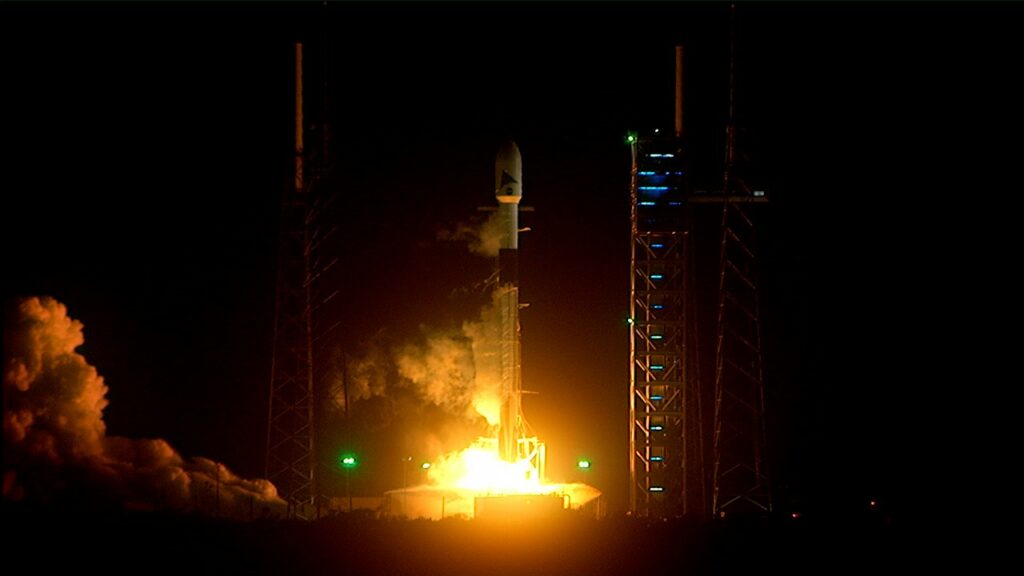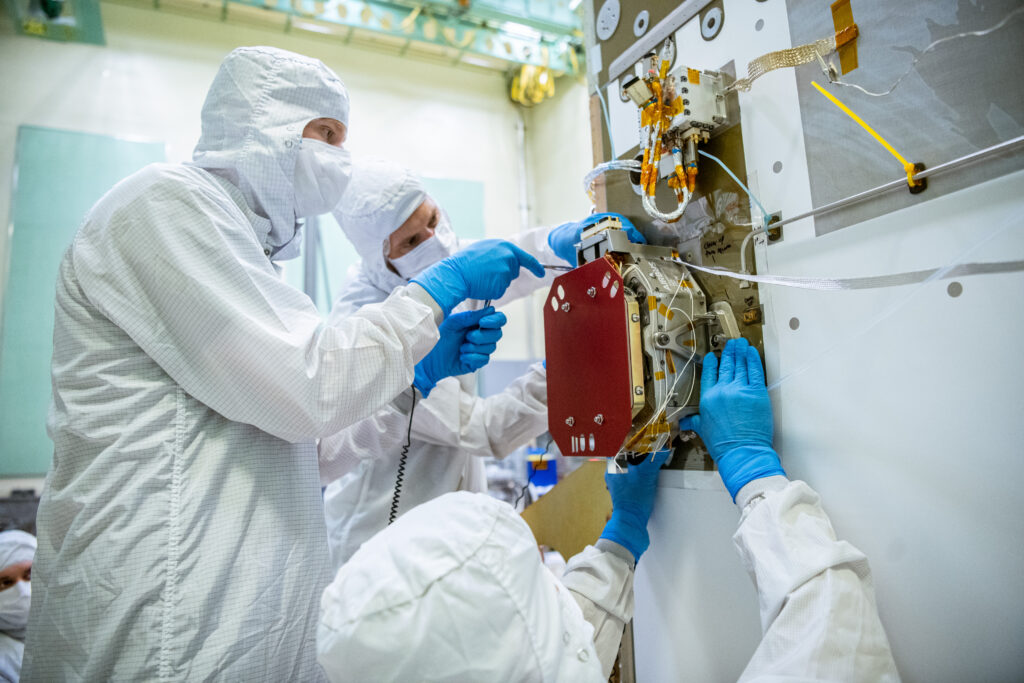(English follows Dutch)
NASA’s klimaatsatelliet PACE is in de vroege ochtend van 8 februari succesvol gelanceerd vanaf Cape Canaveral. PACE gaat metingen doen aan aerosolen, plankton en oceaankleur. Aerosolen zijn de grote onbekende in klimaatmodellen. Het Nederlandse instrument SPEXone gaat daar verandering in brengen via metingen aan aerosolen in de atmosfeer. SPEXone is gebouwd door SRON en Airbus Netherlands B.V., met ondersteuning van TNO.

Lancering PACE-satelliet. Credit: NASA.
Aerosolen zijn kleine deeltjes als roet, as en woestijnstof in de atmosfeer. Ze hebben grote invloed op klimaatverandering en luchtvervuiling, maar hun precieze impact is onduidelijk. Hierdoor liggen de scenario’s voor klimaatopwarming voor het jaar 2100 meerdere graden uit elkaar. De meeste aerosolen weerkaatsen licht, waardoor ze een afkoelend effect op de aarde hebben. Maar ze kunnen door absorptie ook een opwarmend effect hebben.
Klimaatmodellen
Het ruimte-instrument SPEXone gaat de eigenschappen van aerosolen bepalen, zoals grootte, samenstelling, vorm en hun absorberend en weerkaatsend vermogen. ‘Zo kunnen we beter in kaart brengen welk fijnstof in de atmosfeer zit en hoe sterk hun effect is op de wereldwijde temperatuur,’ zegt Otto Hasekamp (SRON). ‘Daarmee verkleinen we de marges in klimaatmodellen en kan de wetenschap scherper voorspellen wat er gebeurt gegeven een bepaalde broeikasgasuitstoot.’
Wolkvorming
Aerosolen beïnvloeden het klimaat ook door hun interactie met wolken. Hasekamp: ‘Water kan condenseren op aerosol-deeltjes waardoor wolkendruppels ontstaan. Als er meer aerosolen zijn, zijn er ook meer wolkendruppels en dit zorgt ervoor dat wolken meer licht reflecteren. Dat geeft dus een afkoelend effect’. Niet alle aerosolen zijn even geschikt om een wolkendruppel te vormen. SPEXone geeft hier meer zicht op. Vervolgens kijken de onderzoekers ook naar de relatie tussen de hoeveelheid aerosolen (instrument SPEXone) en de hoeveelheid wolkendruppels (instrument HARP-2) om te bepalen hoe sterk het effect van aerosol op wolken is.
SPEXone
‘SPEXone meet vanuit de ruimte onder maar liefst vijf verschillende hoeken de polarisatie van het zonlicht dat teruggekaatst wordt door de atmosfeer,’ zegt Wencke van der Meulen, business director atmospheric monitoring instruments bij Airbus Netherlands B.V. ‘Uit die metingen leiden we allerlei informatie af over het aanwezige fijnstof, zoals waaruit dat fijnstof bestaat, de grootte en vorm van de deeltjes en of ze licht absorberen of terugkaatsen. Dat levert cruciale informatie op voor klimaatmodellen, die aan de basis liggen van internationaal beleid rond klimaatverandering.’

Engineers van SRON en Airbus Netherlands B.V. monteren SPEXone op de PACE-satelliet op NASA Goddard Space Flight Center. Credit: NASA
Consortium
Harm van de Wetering, directeur van het Netherlands Space Office (NSO), is trots op deze Nederlandse bijdrage aan de NASA missie: ‘Dit is een prachtig voorbeeld van samenwerking binnen de Nederlandse ruimtevaartsector en tussen Nederland en Amerika, waar ook NASA enorm enthousiast over is. Hier leveren we met onze Nederlandse technologie weer een belangrijk aandeel aan het klimaatonderzoek. Dit is nuttig, maakt trots en inspireert.’
SPEXone is ontwikkeld door een Nederlands consortium bestaande uit SRON en Airbus Netherlands B.V., daarbij ondersteund door opto-mechanische experts van TNO. SRON en Airbus zijn verantwoordelijk voor het ontwerp, de assemblage en het testen van het instrument. De wetenschappelijke leiding ligt in handen van SRON. TNO heeft de vrij-vorm optiek gebouwd. Het concept achter SPEX is bedacht door Frans Snik (Universiteit Leiden). Het NOVA-lab in Dwingeloo heeft een aantal spiegels gepolijst. SPEXone is een publiek-privaat initiatief dat mogelijk gemaakt is door het NSO met door OCW beschikbaar gestelde middelen en door SRON/NWO-I en ondersteund door private investeringen van Airbus Netherlands B.V.
Meer informatie: https://earth.sron.nl/thema/aerosols-and-clouds/
NASA launches climate satellite with Dutch aerosol instrument
NASA’s climate satellite PACE was successfully launched from Cape Canaveral in the early morning of February 8th. PACE will perform measurements on aerosols, plankton and ocean color. Aerosols are a large unknown factor in climate models. The Dutch instrument SPEXone will change this through measurements of aerosols in the atmosphere. SPEXone was built by SRON and Airbus Netherlands B.V., with support from TNO.
Aerosols are small particles such as soot, ash and desert dust in the atmosphere. They have a major influence on climate change and air pollution, but their precise impact is unclear. As a result, the global warming scenarios for the year 2100 are several degrees apart. Most aerosols reflect light, creating a cooling effect. But some have a warming effect through absorption.
Climate models
The SPEXone space instrument will determine the properties of aerosols, such as size, composition, shape and their absorbing and reflective capacity. ‘This way we are able to map out which aerosols are in the atmosphere and how strong their effect is on global temperatures,’ says Otto Hasekamp (SRON). ‘That makes it possible to reduce the margins in climate models and predict more accurately what will happen given certain greenhouse gas emissions.’
Cloud formation
Aerosols also influence the climate through their interaction with clouds. Hasekamp: ‘Water can condensate on aerosol particles, creating cloud droplets. More aerosols give rise to more cloud droplets and this causes clouds to reflect more light. That produces a cooling effect.’ Not all aerosols are equally suitable for forming a cloud droplet. SPEXone provides more insight into this. The researchers then also study the relationship between the amount of aerosols (SPEXone instrument) and the amount of cloud droplets (HARP-2 instrument) to determine how strong the effect of aerosol on clouds is.
SPEXone
‘SPEXone measures the polarization of sunlight reflected by the atmosphere from five different angles,’ says Wencke van der Meulen, business director atmospheric monitoring instruments at Airbus Netherlands B.V. ‘From these measurements we derive all kinds of information about the aerosols present, such as what they consist of, their size and shape and whether they absorb or reflect light. This provides crucial information for climate models, which form the basis of international policy on climate change.’
Consortium
Harm van de Wetering, director of the Netherlands Space Office (NSO), is proud of this Dutch contribution to the NASA mission: ‘This is a wonderful example of collaboration within the Dutch space sector and between The Netherlands and the United States. NASA is also very enthusiastic about this. Once again our Dutch technology has an important share in global climate research. This is useful, inspires and makes us proud.’
SPEXone is developed by a Dutch consortium consisting of SRON and Airbus Netherlands B.V., supported by opto-mechanical experts from TNO. SRON and Airbus are responsible for the design, assembly and testing of the instrument. The scientific leadership is in the hands of SRON. TNO has built the free-form optics. The concept behind SPEX was developed by Frans Snik (Leiden University). The NOVA lab in Dwingeloo has polished a number of mirrors. SPEXone is a public-private initiative made possible by the NSO with resources made available by OCW and by SRON/NWO-I and supported by private investments from Airbus Netherlands B.V.
More information: https://earth.sron.nl/thema/aerosols-and-clouds/


